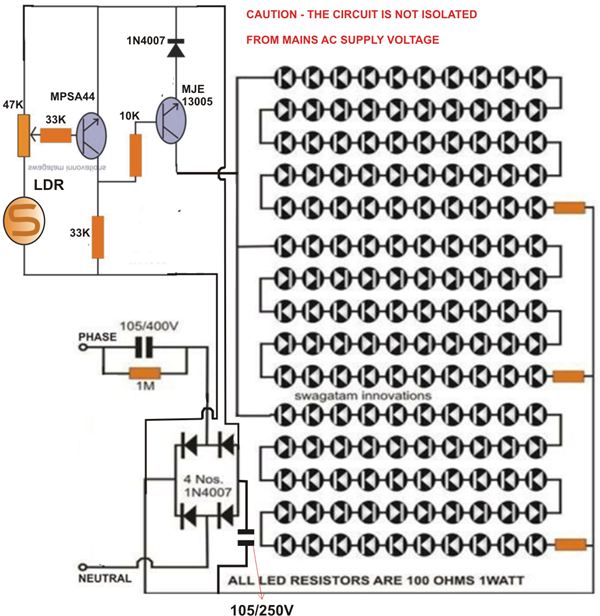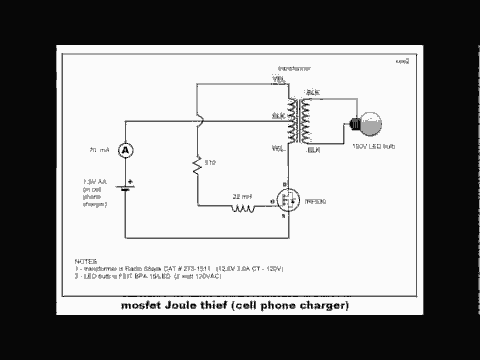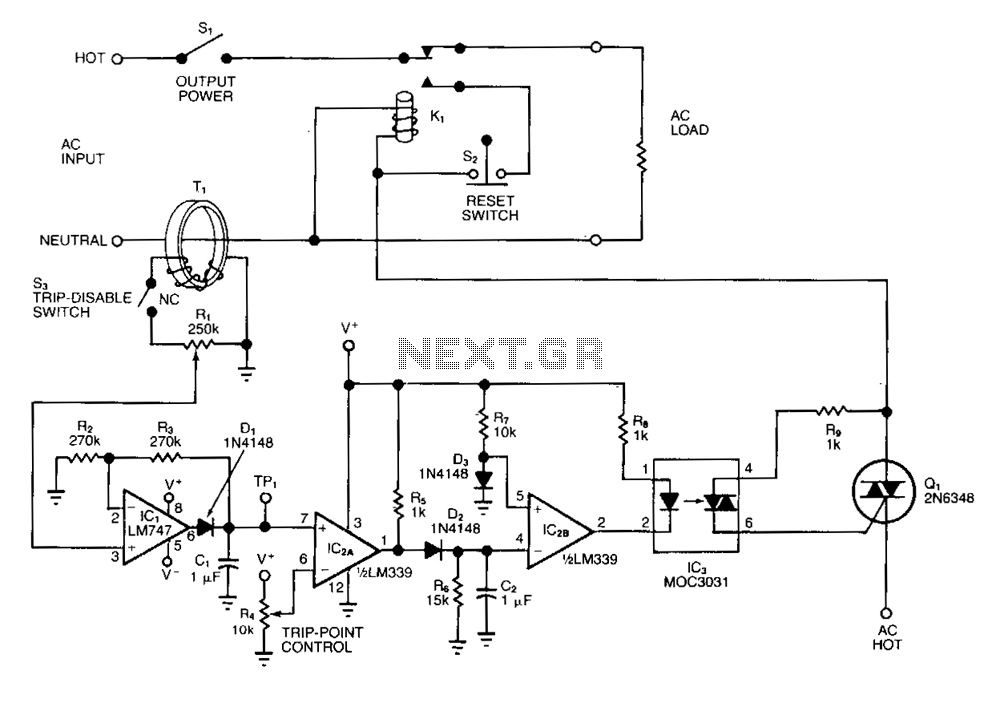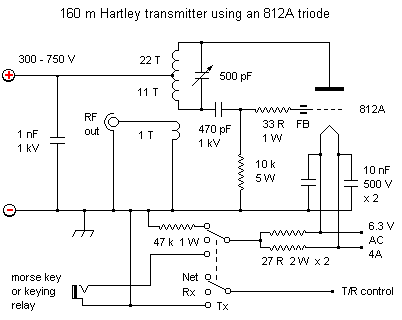
Weekend Projects with Bre Pettis Joule Thief
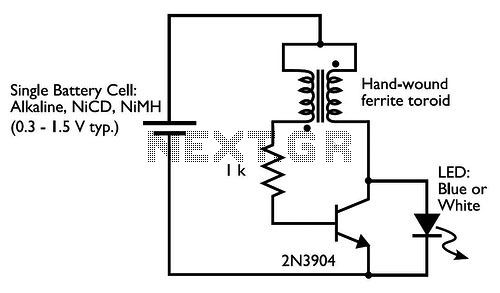
Drive a blue or white LED from a low voltage. Typically, lighting a blue or white LED requires a voltage of 3 to 3.5 V, which can be supplied by a 3 V lithium coin cell. However, a 1.5 V battery, such as a AA cell, is insufficient. The Joule Thief circuit addresses this limitation effectively. It operates not only with a fresh battery but also continues to function until the battery voltage drops to 0.3 V, significantly below the threshold where most devices indicate a dead battery, thereby utilizing the remaining energy from the battery. Instructions for building this circuit can be found in a video available in various formats, which demonstrates both a miniature version suitable for a tiny flashlight and a larger version that is easier to assemble and understand.
In the Joule Thief circuit diagram, the common point of the toroid connects to the positive terminal of the battery. The other two connections from the toroid lead to a resistor and the junction of the transistor and LED. The 2N3904 transistor's symbol indicates that the arrow represents the emitter, the collector is the terminal above it (connected to the LED), and the base is the wire extending to the left between the collector and emitter. The LED's flat side and shorter lead correspond to the flat bar in the circuit diagram. When orienting the transistor with the text readable, the pin configuration from left to right is Emitter, Base, and Collector. This circuit is not the most efficient but is notable for its ability to operate at low voltages, making it ideal for use with depleted batteries rather than fresh ones.
The Joule Thief circuit has garnered attention for its effectiveness and versatility, with users reporting successful operation of multiple LEDs simultaneously from a single 1.5 V battery. Some variations with smaller inductors have also been explored, demonstrating the circuit's adaptability. However, users may encounter unusual behaviors, such as audible high-pitched noises when the circuit is active, which may indicate different oscillation frequencies due to component choices or circuit nonlinearity. The normal operating frequency for Joule Thief circuits is typically around 40 kHz, beyond the range of human hearing, but variations in design can lead to audible outputs.Drive a blue or white LED from a low voltage. Normally, if you want to light up a blue or white LED you need to provide it with 3 3. 5 V, like from a 3 V lithium coin cell. But a 1. 5 V battery like a AA cell simply will not work. But using the Joule Thief, it works like a charm. Not only does it work with a brand new battery, but it works until the battery is nearly dead down to 0. 3 V. That`s well below the point where your other toys will tell you the battery is dead, so it can steal every last joule of energy from the battery (hence the name). To learn how to make one, watch the video, which is available in a variety of formats. The original site where we learned about the Joule thief shows you how to make a miniature version of this circuit, such that you can fit it in a tiny flashlight.
However, in the video we show you how to make it big, large enough (1) to make with clumsy hands and (2) that you can see what we`re doing. In the circuit diagram for the Joule Thief, the common point of the toroid is the connection at the top of the hand-wound ferrite toroid, in the upper right of the diagram.
This goes to the positive end of the battery. The other two wires from the toroid go to the resistor and to the intersection of the transistor with the LED. One other detail that you may need to know is the symbol and pinout of the 2N3904 transistor. In the symbol, the part with the arrow is the emitter , the collector is the end above it, that also connects to the LED, and the base is the wire leading off to the left, between the collector and emitter.
(Also remember that the end of the LED with the flat side and short lead is the end that has the flat bar in the diagram. ) The pins, holding it so that you can read the text on the flat side are (left to right) Emitter, Base, and Collector.
I particularly like this one because it has that little EBC legend on the bottom. As a side note, this is not the most efficient circuit around; its beauty is that it works with such a low voltage. So, this is a great circuit to use with a dead or dying battery, and less so for use with a brand new battery.
Nice job on the podcasts. I`ve been watching Weekend Projects since it started, and this is the second time it has overlapped with some other project I follow. Though this time it`s a double, since it`s you and a circuit from Big Clive`s site. It`s a neat little circuit, and I`m glad to see it get more publicity. I just hope it doesn`t prompt anyone into electrocuting themselves with any of the homer high energy projects of his.
This project is awesome! I`ve already found a couple of uses for it, and even found variations of smaller (but still fully functional) inductors! The capacity of this circuit is amazing aswell! I`ve had a record 6 (six) 3v LEDs working at once with one 1. 5V battery! Not bad for $0. 79 and an old power supply! Cool, I made one :) Something is weird about it though. My Joule Thief makes a soft, very high-pitched noise whenever it is on. Has anyone else noticed that before, and could there be any reason for it Thanks for the explanation on how it works!
The normal range of hearing is up to 20 kHz, in young folks at least. My joule thieves oscillate at about 40 kHz, well outside the range of normal hearing. Since you can hear yours, one of three things is the case. (1) You are not a human. You have super-hearing. You may be a bat, for example, or perhaps a superhero. (2) Your Joule Thief circuit, for whatever reason (choice of toroid ) oscillates at a much lower frequency so that you can hear it. (3) A nonlinearity in the circuit is producing a vibration at half the oscillation frequency, near the uppe
🔗 External reference
In the Joule Thief circuit diagram, the common point of the toroid connects to the positive terminal of the battery. The other two connections from the toroid lead to a resistor and the junction of the transistor and LED. The 2N3904 transistor's symbol indicates that the arrow represents the emitter, the collector is the terminal above it (connected to the LED), and the base is the wire extending to the left between the collector and emitter. The LED's flat side and shorter lead correspond to the flat bar in the circuit diagram. When orienting the transistor with the text readable, the pin configuration from left to right is Emitter, Base, and Collector. This circuit is not the most efficient but is notable for its ability to operate at low voltages, making it ideal for use with depleted batteries rather than fresh ones.
The Joule Thief circuit has garnered attention for its effectiveness and versatility, with users reporting successful operation of multiple LEDs simultaneously from a single 1.5 V battery. Some variations with smaller inductors have also been explored, demonstrating the circuit's adaptability. However, users may encounter unusual behaviors, such as audible high-pitched noises when the circuit is active, which may indicate different oscillation frequencies due to component choices or circuit nonlinearity. The normal operating frequency for Joule Thief circuits is typically around 40 kHz, beyond the range of human hearing, but variations in design can lead to audible outputs.Drive a blue or white LED from a low voltage. Normally, if you want to light up a blue or white LED you need to provide it with 3 3. 5 V, like from a 3 V lithium coin cell. But a 1. 5 V battery like a AA cell simply will not work. But using the Joule Thief, it works like a charm. Not only does it work with a brand new battery, but it works until the battery is nearly dead down to 0. 3 V. That`s well below the point where your other toys will tell you the battery is dead, so it can steal every last joule of energy from the battery (hence the name). To learn how to make one, watch the video, which is available in a variety of formats. The original site where we learned about the Joule thief shows you how to make a miniature version of this circuit, such that you can fit it in a tiny flashlight.
However, in the video we show you how to make it big, large enough (1) to make with clumsy hands and (2) that you can see what we`re doing. In the circuit diagram for the Joule Thief, the common point of the toroid is the connection at the top of the hand-wound ferrite toroid, in the upper right of the diagram.
This goes to the positive end of the battery. The other two wires from the toroid go to the resistor and to the intersection of the transistor with the LED. One other detail that you may need to know is the symbol and pinout of the 2N3904 transistor. In the symbol, the part with the arrow is the emitter , the collector is the end above it, that also connects to the LED, and the base is the wire leading off to the left, between the collector and emitter.
(Also remember that the end of the LED with the flat side and short lead is the end that has the flat bar in the diagram. ) The pins, holding it so that you can read the text on the flat side are (left to right) Emitter, Base, and Collector.
I particularly like this one because it has that little EBC legend on the bottom. As a side note, this is not the most efficient circuit around; its beauty is that it works with such a low voltage. So, this is a great circuit to use with a dead or dying battery, and less so for use with a brand new battery.
Nice job on the podcasts. I`ve been watching Weekend Projects since it started, and this is the second time it has overlapped with some other project I follow. Though this time it`s a double, since it`s you and a circuit from Big Clive`s site. It`s a neat little circuit, and I`m glad to see it get more publicity. I just hope it doesn`t prompt anyone into electrocuting themselves with any of the homer high energy projects of his.
This project is awesome! I`ve already found a couple of uses for it, and even found variations of smaller (but still fully functional) inductors! The capacity of this circuit is amazing aswell! I`ve had a record 6 (six) 3v LEDs working at once with one 1. 5V battery! Not bad for $0. 79 and an old power supply! Cool, I made one :) Something is weird about it though. My Joule Thief makes a soft, very high-pitched noise whenever it is on. Has anyone else noticed that before, and could there be any reason for it Thanks for the explanation on how it works!
The normal range of hearing is up to 20 kHz, in young folks at least. My joule thieves oscillate at about 40 kHz, well outside the range of normal hearing. Since you can hear yours, one of three things is the case. (1) You are not a human. You have super-hearing. You may be a bat, for example, or perhaps a superhero. (2) Your Joule Thief circuit, for whatever reason (choice of toroid ) oscillates at a much lower frequency so that you can hear it. (3) A nonlinearity in the circuit is producing a vibration at half the oscillation frequency, near the uppe
🔗 External reference
Warning: include(partials/cookie-banner.php): Failed to open stream: Permission denied in /var/www/html/nextgr/view-circuit.php on line 713
Warning: include(): Failed opening 'partials/cookie-banner.php' for inclusion (include_path='.:/usr/share/php') in /var/www/html/nextgr/view-circuit.php on line 713
